Detailed Nursing Assessment and Evaluation Report: Mr. William's Care
VerifiedAdded on 2021/02/20
|14
|2239
|62
Report
AI Summary
This report presents a comprehensive nursing assessment of Mr. William, focusing on his physical condition and identified nursing problems. The assessment includes a detailed analysis of vital signs such as heart rate, blood pressure, and respiratory rate, along with neurological and pain level evaluations. The report identifies key nursing problems, including pain, hypertension, bruising, impaired mobility, and potential breathlessness and anxiety. It provides a systematic assessment plan for each problem, outlining assessment questions and rationales. The report also explores the relationship between pain, tachypnea, and tachycardia, and discusses the significance of systematic and comprehensive assessment frameworks, such as holistic and focused assessments. The conclusion emphasizes the importance of using appropriate assessment criteria and models to ensure patient safety and facilitate recovery.
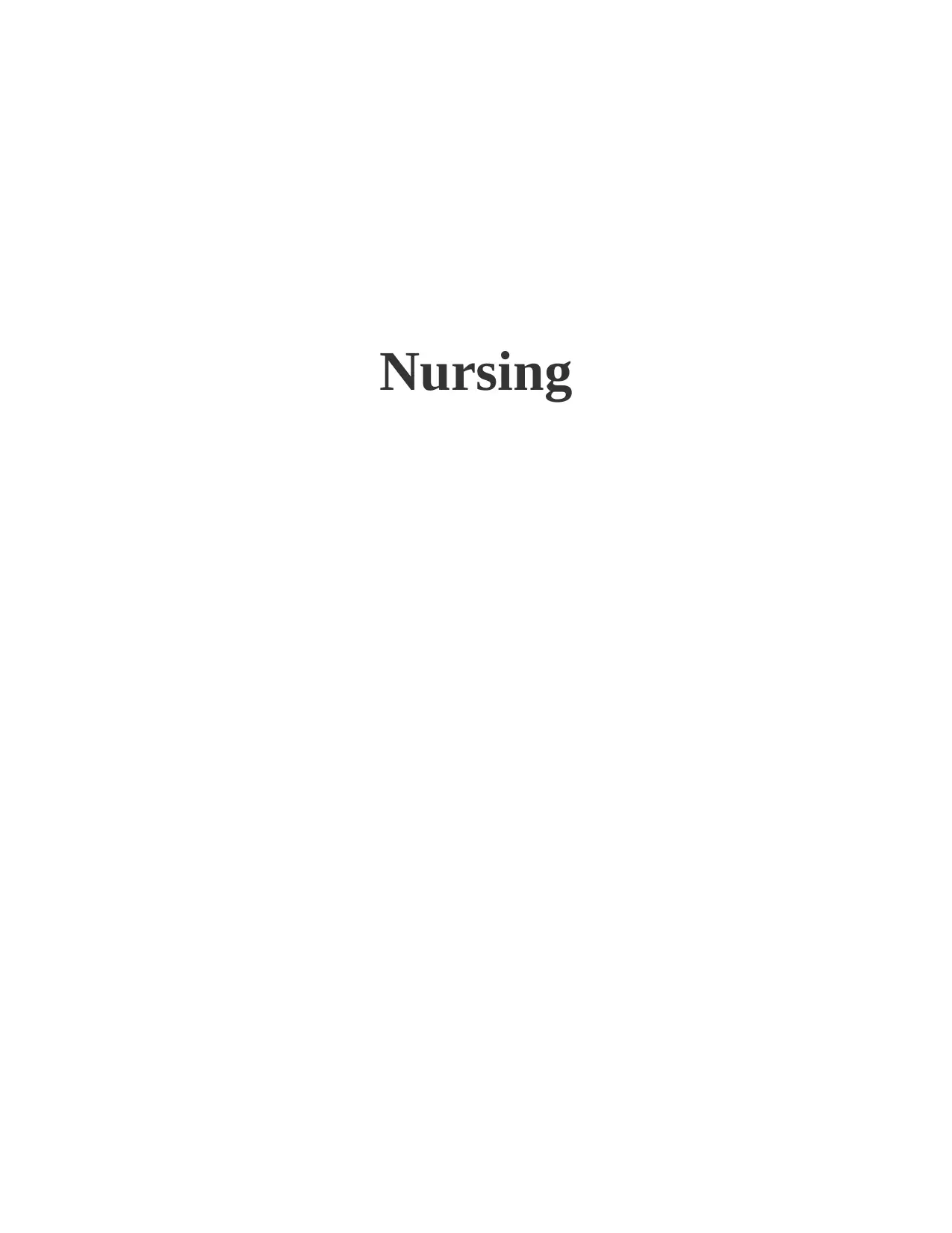
Nursing
Paraphrase This Document
Need a fresh take? Get an instant paraphrase of this document with our AI Paraphraser
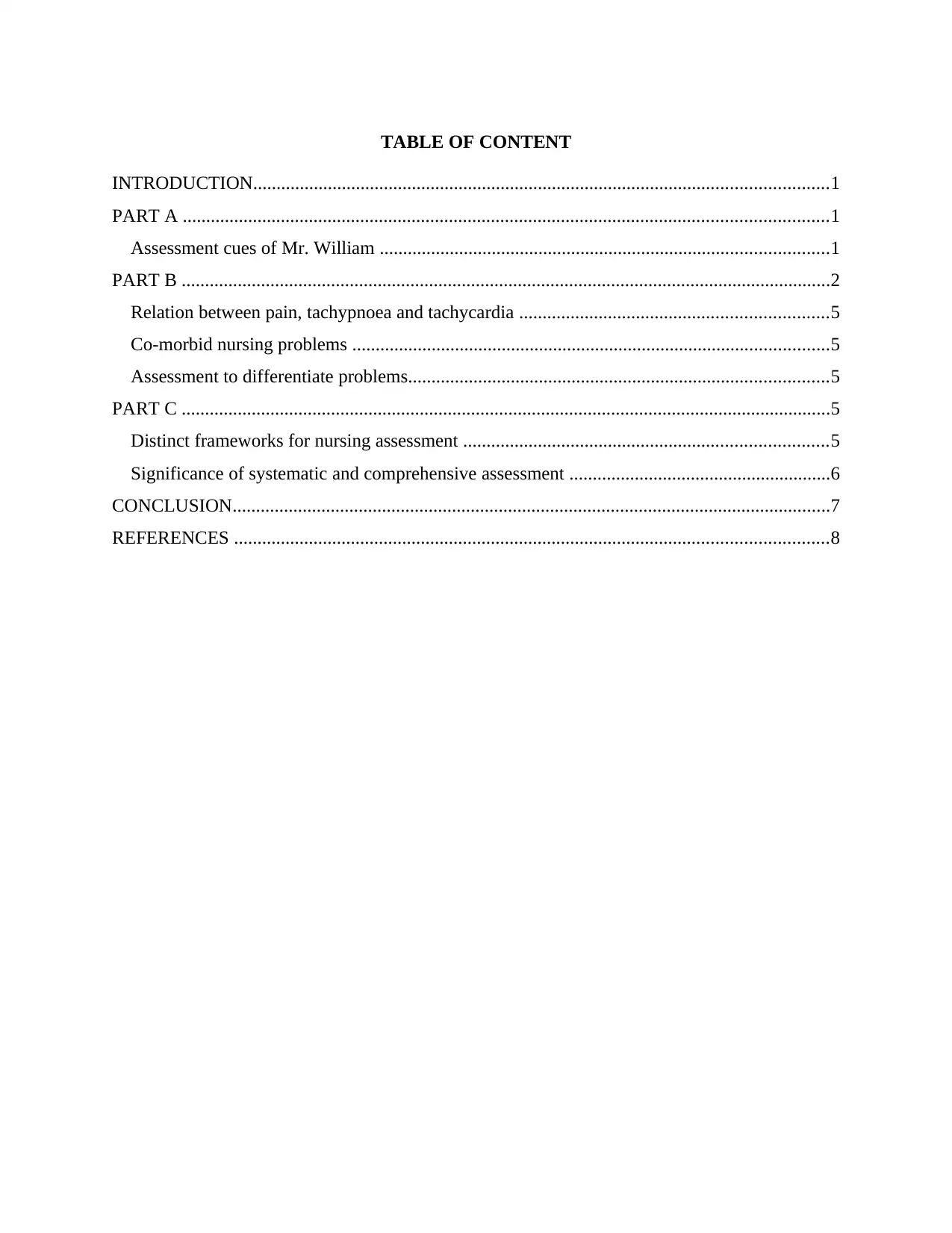
TABLE OF CONTENT
INTRODUCTION...........................................................................................................................1
PART A ..........................................................................................................................................1
Assessment cues of Mr. William ................................................................................................1
PART B ...........................................................................................................................................2
Relation between pain, tachypnoea and tachycardia ..................................................................5
Co-morbid nursing problems ......................................................................................................5
Assessment to differentiate problems..........................................................................................5
PART C ...........................................................................................................................................5
Distinct frameworks for nursing assessment ..............................................................................5
Significance of systematic and comprehensive assessment ........................................................6
CONCLUSION................................................................................................................................7
REFERENCES ...............................................................................................................................8
INTRODUCTION...........................................................................................................................1
PART A ..........................................................................................................................................1
Assessment cues of Mr. William ................................................................................................1
PART B ...........................................................................................................................................2
Relation between pain, tachypnoea and tachycardia ..................................................................5
Co-morbid nursing problems ......................................................................................................5
Assessment to differentiate problems..........................................................................................5
PART C ...........................................................................................................................................5
Distinct frameworks for nursing assessment ..............................................................................5
Significance of systematic and comprehensive assessment ........................................................6
CONCLUSION................................................................................................................................7
REFERENCES ...............................................................................................................................8

INTRODUCTION
The assessment and observation of patient is very critical for providing quality nursing
outcomes. Thus, along with the physical assessment nurses use various methods to assess the
health outcomes of the patient. The report will discuss the assessment and evaluation of a patient
Mr. William so that various nursing problems can be identified can suitable interventions can be
provided.
PART A
Assessment cues of Mr. William
The patient is assessed by the admission assessment approach in which nurses performed
physical assessment, medical history analysis along with the general appearance and
measurement of the patient.
Vital signs:
On the physical assessment and observation following vital signs are recorded.
Neurological system: The patient is in conscious state and is able to make movement in both
limbs. However due to pain and dislocated shoulder he is not showing much movement. Mr.
William is also having 3 fractured ribs on right-hand side making difficulty in movement.
However, there are no symptoms of seizures but strength and coordination of movement is
influenced by the fracture.
Pain level:
The patient informed the pain level as 4/10 on pain assessment scale. The pain is
moderate and patient is given morphine for its management. However due to pain patient is
having limited ambulation.
Cardiovascular outputs: The skin of patient is pale and there is no presence of oedema. The
temperature is slight higher along with the abnormal heart rate. It also elevates the blood pressure
of patient.
Heart rate:
Due to fall event the heart rate of patient is slightly higher and is observed as 105 beats
per minute. The patient is conscious and does not report any event of breathlessness or low
cardiac output.
Blood pressure:
1
The assessment and observation of patient is very critical for providing quality nursing
outcomes. Thus, along with the physical assessment nurses use various methods to assess the
health outcomes of the patient. The report will discuss the assessment and evaluation of a patient
Mr. William so that various nursing problems can be identified can suitable interventions can be
provided.
PART A
Assessment cues of Mr. William
The patient is assessed by the admission assessment approach in which nurses performed
physical assessment, medical history analysis along with the general appearance and
measurement of the patient.
Vital signs:
On the physical assessment and observation following vital signs are recorded.
Neurological system: The patient is in conscious state and is able to make movement in both
limbs. However due to pain and dislocated shoulder he is not showing much movement. Mr.
William is also having 3 fractured ribs on right-hand side making difficulty in movement.
However, there are no symptoms of seizures but strength and coordination of movement is
influenced by the fracture.
Pain level:
The patient informed the pain level as 4/10 on pain assessment scale. The pain is
moderate and patient is given morphine for its management. However due to pain patient is
having limited ambulation.
Cardiovascular outputs: The skin of patient is pale and there is no presence of oedema. The
temperature is slight higher along with the abnormal heart rate. It also elevates the blood pressure
of patient.
Heart rate:
Due to fall event the heart rate of patient is slightly higher and is observed as 105 beats
per minute. The patient is conscious and does not report any event of breathlessness or low
cardiac output.
Blood pressure:
1
⊘ This is a preview!⊘
Do you want full access?
Subscribe today to unlock all pages.

Trusted by 1+ million students worldwide
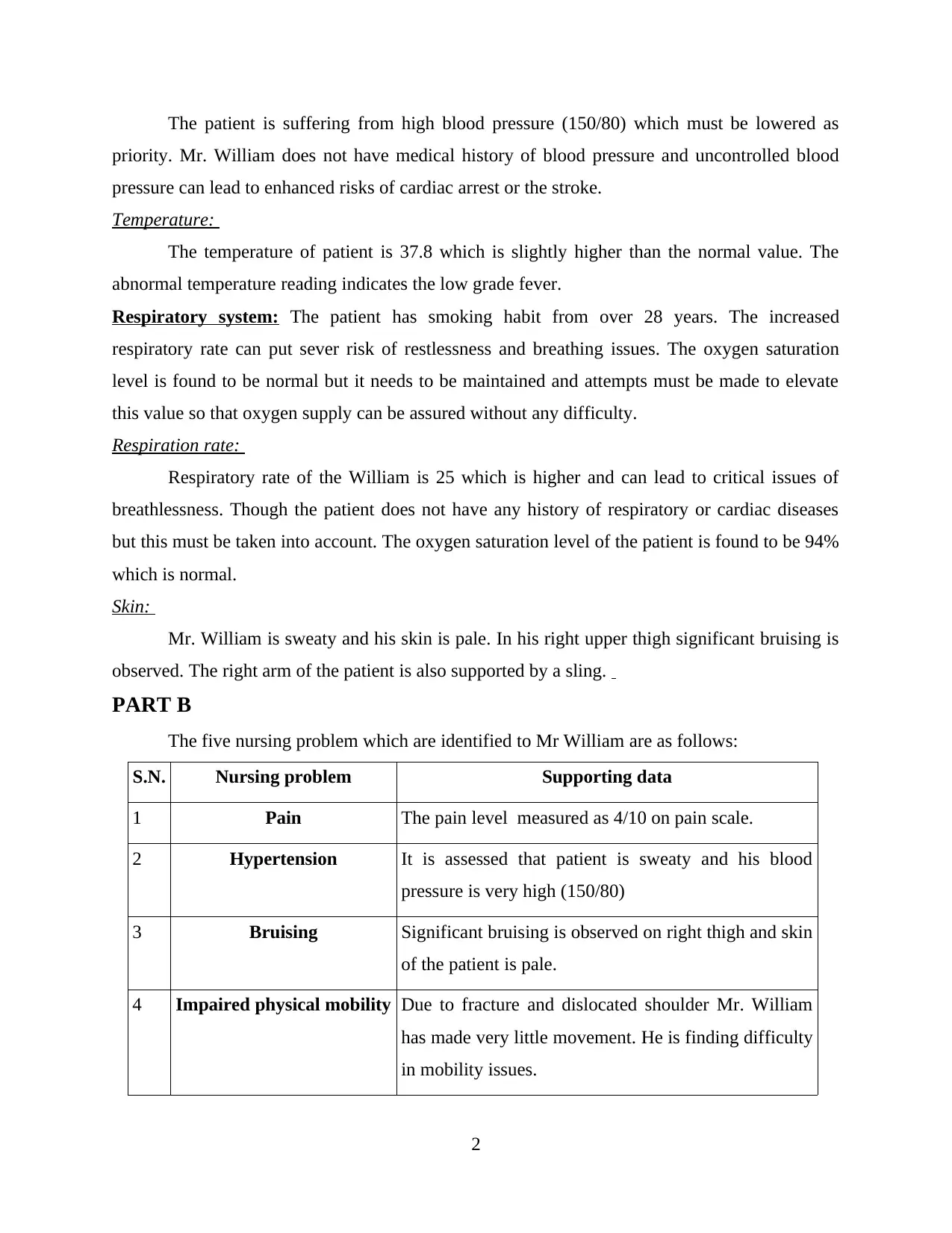
The patient is suffering from high blood pressure (150/80) which must be lowered as
priority. Mr. William does not have medical history of blood pressure and uncontrolled blood
pressure can lead to enhanced risks of cardiac arrest or the stroke.
Temperature:
The temperature of patient is 37.8 which is slightly higher than the normal value. The
abnormal temperature reading indicates the low grade fever.
Respiratory system: The patient has smoking habit from over 28 years. The increased
respiratory rate can put sever risk of restlessness and breathing issues. The oxygen saturation
level is found to be normal but it needs to be maintained and attempts must be made to elevate
this value so that oxygen supply can be assured without any difficulty.
Respiration rate:
Respiratory rate of the William is 25 which is higher and can lead to critical issues of
breathlessness. Though the patient does not have any history of respiratory or cardiac diseases
but this must be taken into account. The oxygen saturation level of the patient is found to be 94%
which is normal.
Skin:
Mr. William is sweaty and his skin is pale. In his right upper thigh significant bruising is
observed. The right arm of the patient is also supported by a sling.
PART B
The five nursing problem which are identified to Mr William are as follows:
S.N. Nursing problem Supporting data
1 Pain The pain level measured as 4/10 on pain scale.
2 Hypertension It is assessed that patient is sweaty and his blood
pressure is very high (150/80)
3 Bruising Significant bruising is observed on right thigh and skin
of the patient is pale.
4 Impaired physical mobility Due to fracture and dislocated shoulder Mr. William
has made very little movement. He is finding difficulty
in mobility issues.
2
priority. Mr. William does not have medical history of blood pressure and uncontrolled blood
pressure can lead to enhanced risks of cardiac arrest or the stroke.
Temperature:
The temperature of patient is 37.8 which is slightly higher than the normal value. The
abnormal temperature reading indicates the low grade fever.
Respiratory system: The patient has smoking habit from over 28 years. The increased
respiratory rate can put sever risk of restlessness and breathing issues. The oxygen saturation
level is found to be normal but it needs to be maintained and attempts must be made to elevate
this value so that oxygen supply can be assured without any difficulty.
Respiration rate:
Respiratory rate of the William is 25 which is higher and can lead to critical issues of
breathlessness. Though the patient does not have any history of respiratory or cardiac diseases
but this must be taken into account. The oxygen saturation level of the patient is found to be 94%
which is normal.
Skin:
Mr. William is sweaty and his skin is pale. In his right upper thigh significant bruising is
observed. The right arm of the patient is also supported by a sling.
PART B
The five nursing problem which are identified to Mr William are as follows:
S.N. Nursing problem Supporting data
1 Pain The pain level measured as 4/10 on pain scale.
2 Hypertension It is assessed that patient is sweaty and his blood
pressure is very high (150/80)
3 Bruising Significant bruising is observed on right thigh and skin
of the patient is pale.
4 Impaired physical mobility Due to fracture and dislocated shoulder Mr. William
has made very little movement. He is finding difficulty
in mobility issues.
2
Paraphrase This Document
Need a fresh take? Get an instant paraphrase of this document with our AI Paraphraser

5 Breathlessness and anxiety The respiration rate, heart rate of the patient are
abnormal, and he is sweaty. In addition to this
smoking habits and ribs fracture can cause fluid in
lungs and thus breathlessness and anxiety can be one
of the potential issue.
For improving the quality of patient care the systematic and detailed assessment of these nursing
problems is as follows:
Problem Assessment plan Rationale for
assessment
Evaluation criteria
or assessment
findings
Pain Open handed question:
Is their constant pain or
it occurs only when
you make movement?
What is the pain level
on scale of 1-10?
Does intake of
morphine is effective in
managing pain?
Further assessment:
Pain level must be assessed in
regular interval.
The uncontrolled pain
can lead to other
clinical complications.
The pain is of
moderate level and
is controlled by
medication.
Hypertension Open handed question:
Do you feel
unconsciousness or
fatigue.
Is there any difficulty
in breathing or
irregularity in heart
Assessment is required
to assure the patient
safety and to avoid
critical risks.
The blood pressure
must be managed as
it can cause stroke or
other cardiovascular
vulnerabilities.
3
abnormal, and he is sweaty. In addition to this
smoking habits and ribs fracture can cause fluid in
lungs and thus breathlessness and anxiety can be one
of the potential issue.
For improving the quality of patient care the systematic and detailed assessment of these nursing
problems is as follows:
Problem Assessment plan Rationale for
assessment
Evaluation criteria
or assessment
findings
Pain Open handed question:
Is their constant pain or
it occurs only when
you make movement?
What is the pain level
on scale of 1-10?
Does intake of
morphine is effective in
managing pain?
Further assessment:
Pain level must be assessed in
regular interval.
The uncontrolled pain
can lead to other
clinical complications.
The pain is of
moderate level and
is controlled by
medication.
Hypertension Open handed question:
Do you feel
unconsciousness or
fatigue.
Is there any difficulty
in breathing or
irregularity in heart
Assessment is required
to assure the patient
safety and to avoid
critical risks.
The blood pressure
must be managed as
it can cause stroke or
other cardiovascular
vulnerabilities.
3
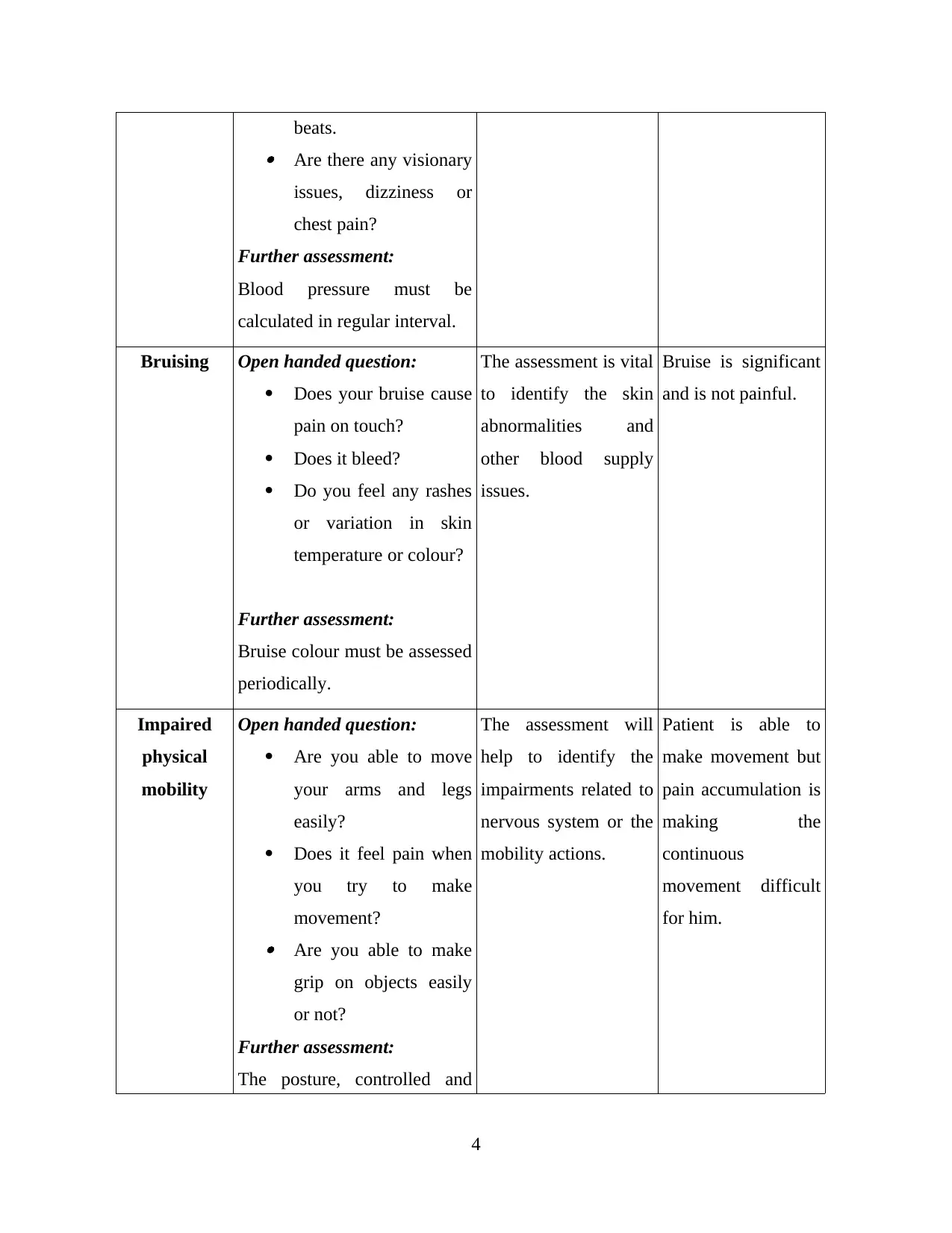
beats.
Are there any visionary
issues, dizziness or
chest pain?
Further assessment:
Blood pressure must be
calculated in regular interval.
Bruising Open handed question:
Does your bruise cause
pain on touch?
Does it bleed?
Do you feel any rashes
or variation in skin
temperature or colour?
Further assessment:
Bruise colour must be assessed
periodically.
The assessment is vital
to identify the skin
abnormalities and
other blood supply
issues.
Bruise is significant
and is not painful.
Impaired
physical
mobility
Open handed question:
Are you able to move
your arms and legs
easily?
Does it feel pain when
you try to make
movement?
Are you able to make
grip on objects easily
or not?
Further assessment:
The posture, controlled and
The assessment will
help to identify the
impairments related to
nervous system or the
mobility actions.
Patient is able to
make movement but
pain accumulation is
making the
continuous
movement difficult
for him.
4
Are there any visionary
issues, dizziness or
chest pain?
Further assessment:
Blood pressure must be
calculated in regular interval.
Bruising Open handed question:
Does your bruise cause
pain on touch?
Does it bleed?
Do you feel any rashes
or variation in skin
temperature or colour?
Further assessment:
Bruise colour must be assessed
periodically.
The assessment is vital
to identify the skin
abnormalities and
other blood supply
issues.
Bruise is significant
and is not painful.
Impaired
physical
mobility
Open handed question:
Are you able to move
your arms and legs
easily?
Does it feel pain when
you try to make
movement?
Are you able to make
grip on objects easily
or not?
Further assessment:
The posture, controlled and
The assessment will
help to identify the
impairments related to
nervous system or the
mobility actions.
Patient is able to
make movement but
pain accumulation is
making the
continuous
movement difficult
for him.
4
⊘ This is a preview!⊘
Do you want full access?
Subscribe today to unlock all pages.

Trusted by 1+ million students worldwide
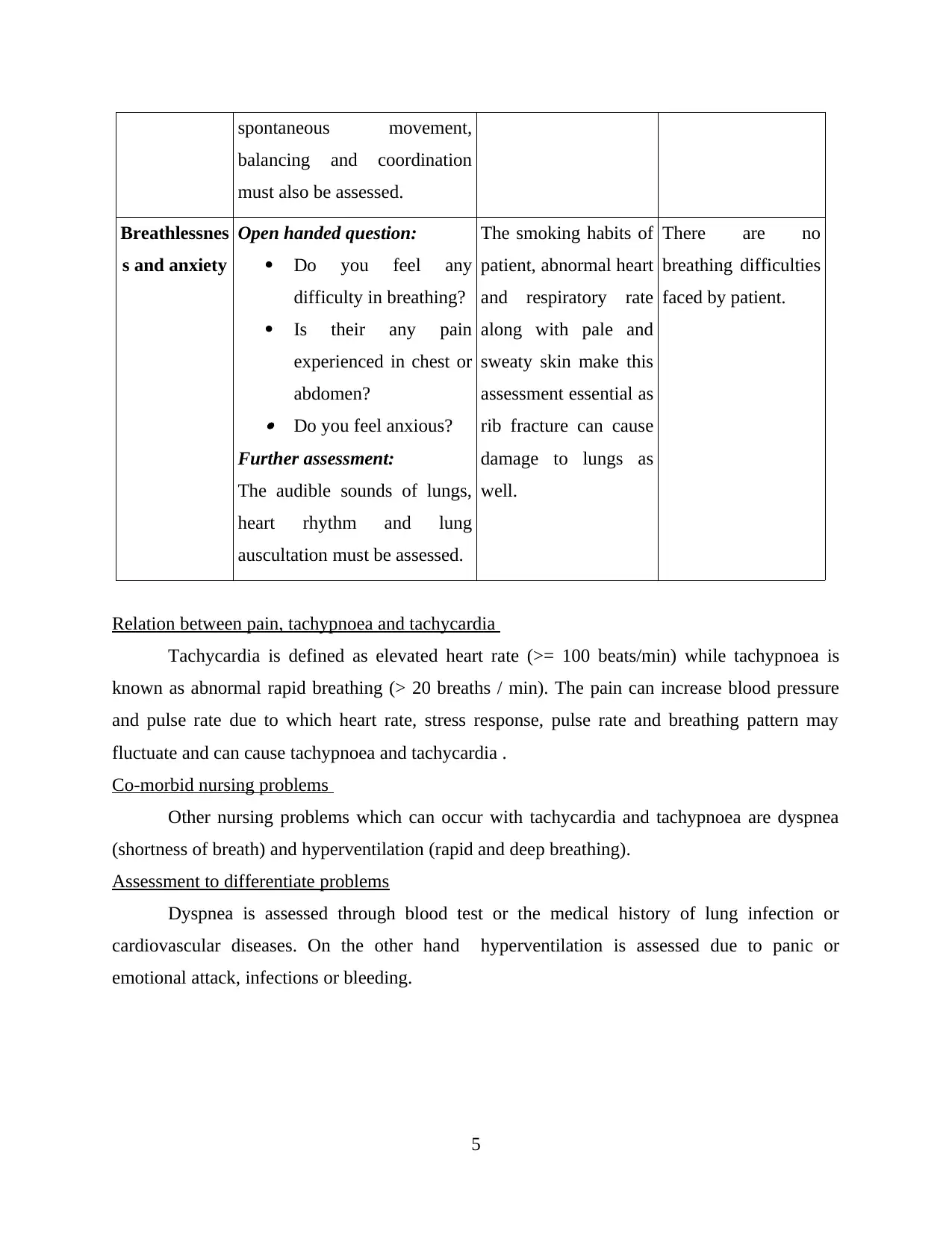
spontaneous movement,
balancing and coordination
must also be assessed.
Breathlessnes
s and anxiety
Open handed question:
Do you feel any
difficulty in breathing?
Is their any pain
experienced in chest or
abdomen?
Do you feel anxious?
Further assessment:
The audible sounds of lungs,
heart rhythm and lung
auscultation must be assessed.
The smoking habits of
patient, abnormal heart
and respiratory rate
along with pale and
sweaty skin make this
assessment essential as
rib fracture can cause
damage to lungs as
well.
There are no
breathing difficulties
faced by patient.
Relation between pain, tachypnoea and tachycardia
Tachycardia is defined as elevated heart rate (>= 100 beats/min) while tachypnoea is
known as abnormal rapid breathing (> 20 breaths / min). The pain can increase blood pressure
and pulse rate due to which heart rate, stress response, pulse rate and breathing pattern may
fluctuate and can cause tachypnoea and tachycardia .
Co-morbid nursing problems
Other nursing problems which can occur with tachycardia and tachypnoea are dyspnea
(shortness of breath) and hyperventilation (rapid and deep breathing).
Assessment to differentiate problems
Dyspnea is assessed through blood test or the medical history of lung infection or
cardiovascular diseases. On the other hand hyperventilation is assessed due to panic or
emotional attack, infections or bleeding.
5
balancing and coordination
must also be assessed.
Breathlessnes
s and anxiety
Open handed question:
Do you feel any
difficulty in breathing?
Is their any pain
experienced in chest or
abdomen?
Do you feel anxious?
Further assessment:
The audible sounds of lungs,
heart rhythm and lung
auscultation must be assessed.
The smoking habits of
patient, abnormal heart
and respiratory rate
along with pale and
sweaty skin make this
assessment essential as
rib fracture can cause
damage to lungs as
well.
There are no
breathing difficulties
faced by patient.
Relation between pain, tachypnoea and tachycardia
Tachycardia is defined as elevated heart rate (>= 100 beats/min) while tachypnoea is
known as abnormal rapid breathing (> 20 breaths / min). The pain can increase blood pressure
and pulse rate due to which heart rate, stress response, pulse rate and breathing pattern may
fluctuate and can cause tachypnoea and tachycardia .
Co-morbid nursing problems
Other nursing problems which can occur with tachycardia and tachypnoea are dyspnea
(shortness of breath) and hyperventilation (rapid and deep breathing).
Assessment to differentiate problems
Dyspnea is assessed through blood test or the medical history of lung infection or
cardiovascular diseases. On the other hand hyperventilation is assessed due to panic or
emotional attack, infections or bleeding.
5
Paraphrase This Document
Need a fresh take? Get an instant paraphrase of this document with our AI Paraphraser

PART C
Distinct frameworks for nursing assessment
The nursing framework aims at collecting relevant information of patient including their
physiology, sociological, spiritual and psychological needs. The two distinct frameworks which
can be used by nurses is holistic framework and focused assessment framework. Thus instead of
emphasizing on only physical health nurses must assess the emotional, mental as well as spiritual
health of patient. This type of assessment is known as holistic assessment and provides more
precise and valuable information for diagnosis and planning.
Another assessment framework which can be used by nurses is called focused
assessment. The framework is very much suitable for the acute care as it assess the specific
systems of the body by relating them to current situation of patient. With the use of this
assessment framework nurses are required to utilize their clinical judgements to assess the
elements of focussed assessment. The common physical systems which are being assessed in
focused assessment includes cardiovascular system, nervous system, respiratory, gastrointestinal,
renal, musculoskeletal , psychosocial and endocrine system.
Significance of systematic and comprehensive assessment
As per the standard 4 of NMBA nurses must conduct comprehensive assessment of their
patient to assure their safety. Thus, assessment framework chosen by the nurses must be highly
effective and must deliver precise results. One of the advantage of using holistic assessment is
that it identify all needs of patients instead of limiting to only physical systems. Thus, nurses can
provide improved patient centred care (Shen, 2015). However one of its weakness is that due to
limited evidences and analysis it may not successfully identify all the possible risk factors.
Contrary to the holistic assessment, focused assessment is put more emphasis on
physiology of the patient instead of other social or psychological factors. This feature can act as
major weakness in providing more patient centred care. The most impactful factor which can be
considered as the strength of focussed assessment is that it provides in depth assessment of all
the physical system (Yudkowsky, Park & Downing, 2019). Thus risk vulnerabilities are easy to
identify and an improved care plan with minimum risk factors can be developed.
For my future practice of registered nurse systematic and comprehensive assessment is
very essential. The comprehensive approach can assist me to monitor and govern all parameters
which have correlation or morbidity with clinical issue. The clinical injury to any one system can
6
Distinct frameworks for nursing assessment
The nursing framework aims at collecting relevant information of patient including their
physiology, sociological, spiritual and psychological needs. The two distinct frameworks which
can be used by nurses is holistic framework and focused assessment framework. Thus instead of
emphasizing on only physical health nurses must assess the emotional, mental as well as spiritual
health of patient. This type of assessment is known as holistic assessment and provides more
precise and valuable information for diagnosis and planning.
Another assessment framework which can be used by nurses is called focused
assessment. The framework is very much suitable for the acute care as it assess the specific
systems of the body by relating them to current situation of patient. With the use of this
assessment framework nurses are required to utilize their clinical judgements to assess the
elements of focussed assessment. The common physical systems which are being assessed in
focused assessment includes cardiovascular system, nervous system, respiratory, gastrointestinal,
renal, musculoskeletal , psychosocial and endocrine system.
Significance of systematic and comprehensive assessment
As per the standard 4 of NMBA nurses must conduct comprehensive assessment of their
patient to assure their safety. Thus, assessment framework chosen by the nurses must be highly
effective and must deliver precise results. One of the advantage of using holistic assessment is
that it identify all needs of patients instead of limiting to only physical systems. Thus, nurses can
provide improved patient centred care (Shen, 2015). However one of its weakness is that due to
limited evidences and analysis it may not successfully identify all the possible risk factors.
Contrary to the holistic assessment, focused assessment is put more emphasis on
physiology of the patient instead of other social or psychological factors. This feature can act as
major weakness in providing more patient centred care. The most impactful factor which can be
considered as the strength of focussed assessment is that it provides in depth assessment of all
the physical system (Yudkowsky, Park & Downing, 2019). Thus risk vulnerabilities are easy to
identify and an improved care plan with minimum risk factors can be developed.
For my future practice of registered nurse systematic and comprehensive assessment is
very essential. The comprehensive approach can assist me to monitor and govern all parameters
which have correlation or morbidity with clinical issue. The clinical injury to any one system can
6
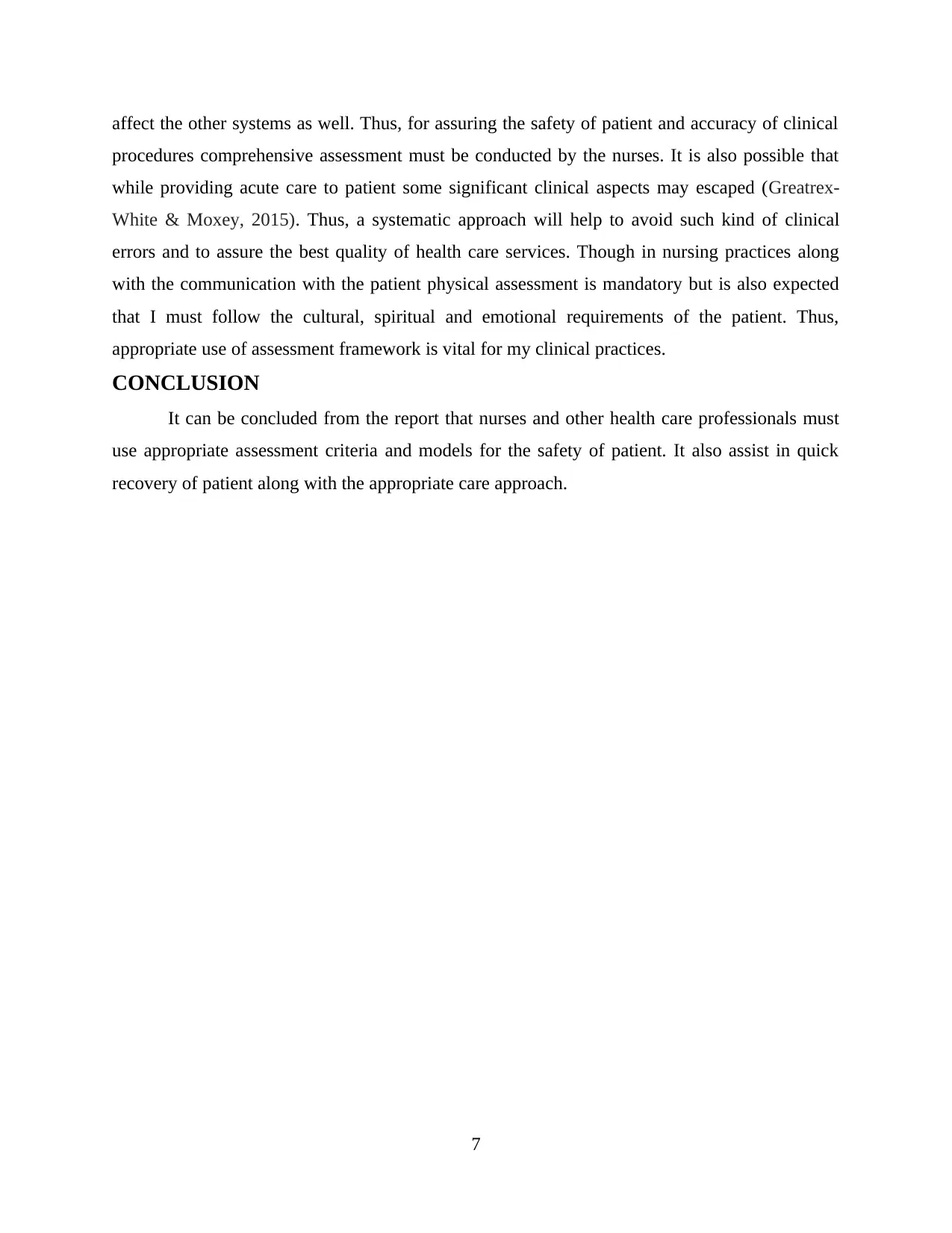
affect the other systems as well. Thus, for assuring the safety of patient and accuracy of clinical
procedures comprehensive assessment must be conducted by the nurses. It is also possible that
while providing acute care to patient some significant clinical aspects may escaped (Greatrex‐
White & Moxey, 2015). Thus, a systematic approach will help to avoid such kind of clinical
errors and to assure the best quality of health care services. Though in nursing practices along
with the communication with the patient physical assessment is mandatory but is also expected
that I must follow the cultural, spiritual and emotional requirements of the patient. Thus,
appropriate use of assessment framework is vital for my clinical practices.
CONCLUSION
It can be concluded from the report that nurses and other health care professionals must
use appropriate assessment criteria and models for the safety of patient. It also assist in quick
recovery of patient along with the appropriate care approach.
7
procedures comprehensive assessment must be conducted by the nurses. It is also possible that
while providing acute care to patient some significant clinical aspects may escaped (Greatrex‐
White & Moxey, 2015). Thus, a systematic approach will help to avoid such kind of clinical
errors and to assure the best quality of health care services. Though in nursing practices along
with the communication with the patient physical assessment is mandatory but is also expected
that I must follow the cultural, spiritual and emotional requirements of the patient. Thus,
appropriate use of assessment framework is vital for my clinical practices.
CONCLUSION
It can be concluded from the report that nurses and other health care professionals must
use appropriate assessment criteria and models for the safety of patient. It also assist in quick
recovery of patient along with the appropriate care approach.
7
⊘ This is a preview!⊘
Do you want full access?
Subscribe today to unlock all pages.

Trusted by 1+ million students worldwide
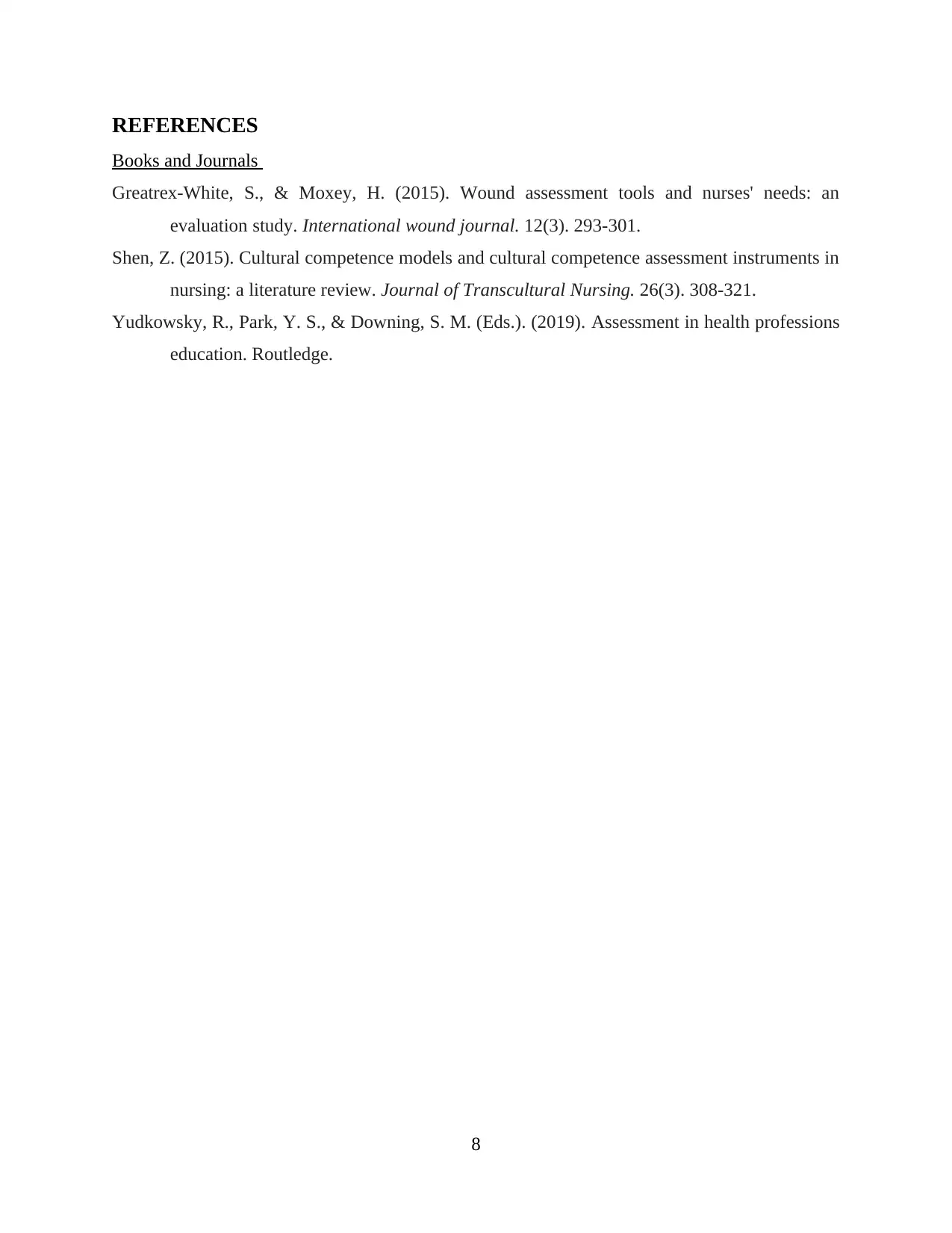
REFERENCES
Books and Journals
Greatrex‐White, S., & Moxey, H. (2015). Wound assessment tools and nurses' needs: an
evaluation study. International wound journal. 12(3). 293-301.
Shen, Z. (2015). Cultural competence models and cultural competence assessment instruments in
nursing: a literature review. Journal of Transcultural Nursing. 26(3). 308-321.
Yudkowsky, R., Park, Y. S., & Downing, S. M. (Eds.). (2019). Assessment in health professions
education. Routledge.
8
Books and Journals
Greatrex‐White, S., & Moxey, H. (2015). Wound assessment tools and nurses' needs: an
evaluation study. International wound journal. 12(3). 293-301.
Shen, Z. (2015). Cultural competence models and cultural competence assessment instruments in
nursing: a literature review. Journal of Transcultural Nursing. 26(3). 308-321.
Yudkowsky, R., Park, Y. S., & Downing, S. M. (Eds.). (2019). Assessment in health professions
education. Routledge.
8
Paraphrase This Document
Need a fresh take? Get an instant paraphrase of this document with our AI Paraphraser

9

10
⊘ This is a preview!⊘
Do you want full access?
Subscribe today to unlock all pages.

Trusted by 1+ million students worldwide
1 out of 14
Related Documents
Your All-in-One AI-Powered Toolkit for Academic Success.
+13062052269
info@desklib.com
Available 24*7 on WhatsApp / Email
![[object Object]](/_next/static/media/star-bottom.7253800d.svg)
Unlock your academic potential
Copyright © 2020–2025 A2Z Services. All Rights Reserved. Developed and managed by ZUCOL.





